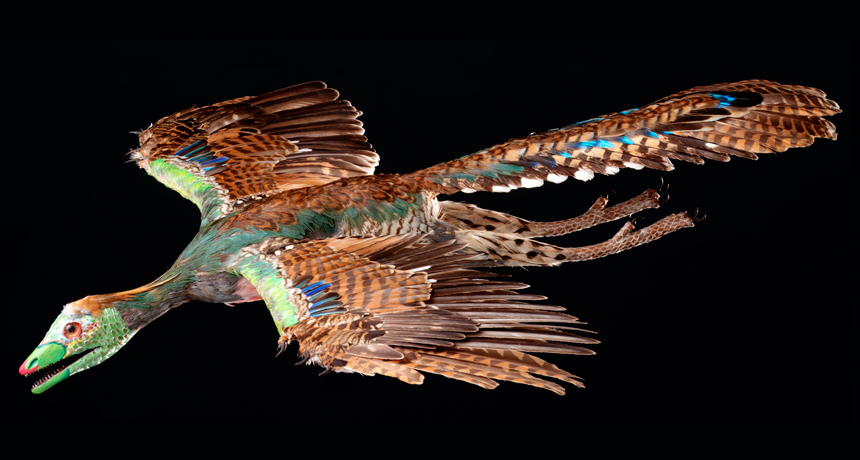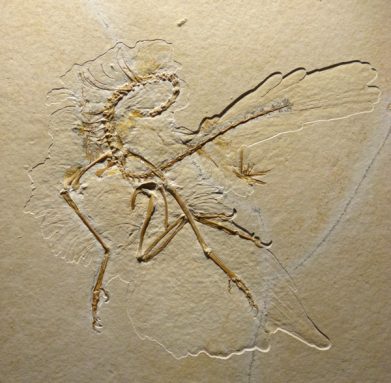This dino-bird is super-feathered
Feathered neck-to-toe, it didn’t fly but could glide

This artist’s depiction shows new view of Archaeopteryx, a dino-bird. Although it did not fly, it could glide. New fossil shows feathers covered even its legs.
BAVARIAN STATE ARCHAEOLOGICAL COLLECTION
One of the earliest birds roamed 150 million years ago. This was during the late Jurassic period, the heyday of dinosaurs. Named Archaeopteryx (AR-kee-OP-tur-iks), this flight-less fowl grew to the size of a well-fed pigeon. A new fossil of the bird is now ruffling scientists’ beliefs about what drove the early evolution of feathers.
Archaeopteryx spanned the evolutionary gap between feathered dinosaurs and modern birds. While a true bird, it was also a dinosaur, Christian Foth told Science News for Students. A paleontologist — someone who studies the remains of prehistoric life — Foth works at Ludwig Maximilian University in Munich, Germany. Indeed, he argues, even today’s birds might be viewed of as a type of remnant dinosaur.
Foth’s team recently unearthed a new fossil of Archaeopteryx.

It is only the 11th example of this bird known. The species already was known for its feathers. But this well-preserved fossil shows quill-like feathers in places the researchers had not expected. Plumes covered not only its wings and tail but also its body and legs. Foth and his team share their new findings July 2 in the journal Nature.
Their group compared where feathers showed up on this bird to those seen on fossils of other ancient birds and conventional dinosaurs. Foth’s team found a surprising variation in feather style and placement. This variety implies that many different uses drove the emergence and evolution of early plumage. Those feather uses would have included insulation and mating displays. Feathers were repurposed for flight only later, the team concludes.
Power Words
birds Warm-blooded animals with wings that first showed up during the time of the dinosaurs. Birds are jacketed in feathers and produce young from the eggs they deposit in some sort of nest. Most birds fly, but throughout history there have been the occasional species that don’t.
dinosaur A term that means terrible lizard. These ancient reptiles lived from about 250 million years ago to roughly 65 million years ago. All descended from egg-laying reptiles known as archosaurs. Their descendants eventually split into two lines. They are distinguished by their hips. The lizard-hipped line became saurichians, such as two-footed theropods like T. rex and the lumbering four-footed Apatosaurus (once known as brontosaurus). A second line of so-called bird-hipped, or ornithischian dinosaurs, led to a widely differing group of animals that included the stegosaurs and duckbilled dinosaurs.
evolution A process by which species undergo changes over time, usually through genetic variation and natural selection. These changes usually result in a new type of organism better suited for its environment than the earlier type. The newer type is not necessarily more “advanced,” just better adapted to the conditions in which it developed.
fossil Any preserved remains or traces of ancient life. There are many different types of fossils: The bones and other body parts of dinosaurs are called “body fossils.” Things like footprints are called “trace fossils.” Even specimens of dinosaur poop are fossils.
Jurassic Lasting from about 200 million to 145.5 million years ago, it’s the middle period of the Mesozoic Era. This was a time when dinosaurs were the dominant form of life on land.
mating display The activities that an animal undertakes to attract the attention of a potential mate and to display his (or her) potential appeal as a good protector, parent or forager. In some displays, a bird may fan open its tail feathers or dance in a way that exaggerates its size and ferociousness. Other times, an animal may sing or strut or bring gifts of food or environmental bling to the individual it is trying to impress.
paleontology The branch of science concerned with ancient, fossilized animals and plants. A scientist who works in this field is known as a paleontologist.
plumage A term for the collection of feathers covering a bird. A single large feather may be called a plume.
quill The long, hard and hollow section of a bird’s feather that attaches to its body. It’s also the name for the disposable spear-like spines, used for protection, that cover the body of a porcupine or hedgehog.
remnant Something that is leftover — from another piece of something, from another time or even some features from an earlier species.







